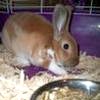| Back to Back Issues Page |
 |
|
Rabbit Rhythm Newsletter #010 - Breeding in Winter, sexing rabbits, and more November 17, 2010 |
Rabbit Rhythms of DecemberRabbits laugh at winter. They grow thick coats that enable them to withstand frigid weather. And as the weather turns cold, rabbits begin to do what they do best - multiply! For a rabbit farmer, this is good news, since does have been turning up their noses at the bucks through most of autumn. Rabbits are seasonal, especially when it comes to breeding. Commercial rabbit production operations have climate-controlled facilities with extra lighting to simulate long spring days, but we still think a little internal clock inside the rabbits holds some influence over them. If you notice that does resist breeding in autumn, this may be why. In the wild, rabbits stop breeding as early as July, depending on the local climate. During the off-season, bucks peacefully coexist without fighting, and no one mates. The entire warren is in recovery and health-rebuilding for the up-coming breeding season. When is that? Late fall, surprisingly enough! Rabbits begin breeding as the temperatures drop into their winter lows, which is as early as October to November. Wild rabbits have their first litters of the season in late November or early December, and will rebreed as rapidly as the day after kindling a litter. Of course, if the food sources aren’t rich and full of energy, the does are not likely to kindle many babies at one time, and only 3-4 may survive to weaning. Of these, up to three of the four may be taken by predators. (Don’t feel sad - this is the role of the rabbit in a healthy ecosystem.) But thanks to their successful and rapid rebreeding capabilities, the rabbit population remains stable or grows, despite predation. What does this mean for a rabbit breeder? Take advantage of the rabbits’ natural, wild, rhythms, and start breeding those does! Your does may already be more willing to breed now that we're approaching December. If not, they soon will be. Plus, take thought to keeping the kits warm through the winter months. The doe will do all she can to keep her kits safe and warm in the dead of winter, with a little help from you...
New Information on Raising-Rabbits.com1) Our Rabbit Breed Descriptions page got too long! It now includes only the breeds from A - F, and we added two additional pages to cover G-N, and O-Z. We still have a ways to go before finishing that last O-Z page. (We knew it would be a biiig undertaking!) Once complete, we plan to create dedicated description pages for many, if not most, of the ARBA-sanctioned breeds. For example, see our new Chinchilla rabbits page.You'll find links to all the breeds at Rabbit Breeds.
2) Raising-Rabbits wanted to make it easier for you to verify the gender of your rabbits.
Rabbits in the NewsThanks to rabbits (and researchers), there is potentially great news for arthritis sufferers and those with severe joint injuries."Rabbits implanted with artificial bones re-grew their own joints, complete with cartilage," reported researchers on July 28, 2010. Read the full story here.
Like this newsletter?Forward this email to your friends!Your friends at Raising-Rabbits.com wish you a very Happy (and grateful) Thanksgiving.
|
| Back to Back Issues Page |
